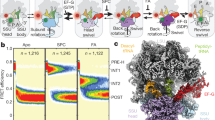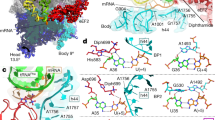Abstract
During the translocation step of protein synthesis, a complex of two transfer RNAs bound to messenger RNA (tRNA–mRNA) moves through the ribosome. The reaction is promoted by an elongation factor, called EF-G in bacteria, which, powered by GTP hydrolysis, induces an open, unlocked conformation of the ribosome that allows for spontaneous tRNA–mRNA movement. Here we show that, in the absence of EF-G, there is spontaneous backward movement, or retrotranslocation, of two tRNAs bound to mRNA. Retrotranslocation is driven by the gain in affinity when a cognate E-site tRNA moves into the P site, which compensates the affinity loss accompanying the movement of peptidyl-tRNA from the P to the A site. These results lend support to the diffusion model of tRNA movement during translocation. In the cell, tRNA movement is biased in the forward direction by EF-G, which acts as a Brownian ratchet and prevents backward movement.
This is a preview of subscription content, access via your institution
Access options
Subscribe to this journal
Receive 12 print issues and online access
$189.00 per year
only $15.75 per issue
Buy this article
- Purchase on Springer Link
- Instant access to full article PDF
Prices may be subject to local taxes which are calculated during checkout





Similar content being viewed by others
References
Rodnina, M.V., Savelsbergh, A., Katunin, V.I. & Wintermeyer, W. Hydrolysis of GTP by elongation factor G drives tRNA movement on the ribosome. Nature 385, 37–41 (1997).
Gavrilova, L.P. & Spirin, A.S. “Nonenzymatic” translation. Methods Enzymol. 30, 452–462 (1974).
Gavrilova, L.P., Kostiashkina, O.E., Koteliansky, V.E., Rutkevitch, N.M. & Spirin, A.S. Factor-free (“non-enzymic”) and factor-dependent systems of translation of polyuridylic acid by Escherichia coli ribosomes. J. Mol. Biol. 101, 537–552 (1976).
Southworth, D.R., Brunelle, J.L. & Green, R. EF-G-independent translocation of the mRNA:tRNA complex is promoted by modification of the ribosome with thiol-specific reagents. J. Mol. Biol. 324, 611–623 (2002).
Fredrick, K. & Noller, H.F. Catalysis of ribosomal translocation by sparsomycin. Science 300, 1159–1162 (2003).
Semenkov, Y.P., Shapkina, T.G. & Kirillov, S.V. Puromycin reaction of the A-site bound peptidyl-tRNA. Biochimie 74, 411–417 (1992).
Semenkov, Y., Shapkina, T., Makhno, V. & Kirillov, S. Puromycin reaction for the A site-bound peptidyl-tRNA. FEBS Lett. 296, 207–210 (1992).
Moazed, D. & Noller, H.F. Intermediate states in the movement of transfer RNA in the ribosome. Nature 342, 142–148 (1989).
Sharma, D., Southworth, D.R. & Green, R. EF-G-independent reactivity of a pre-translocation-state ribosome complex with the aminoacyl tRNA substrate puromycin supports an intermediate (hybrid) state of tRNA binding. RNA 10, 102–113 (2004).
Hansen, J.L., Schmeing, T.M., Moore, P.B. & Steitz, T.A. Structural insights into peptide bond formation. Proc. Natl. Acad. Sci. USA 99, 11670–11675 (2002).
Cukras, A.R., Southworth, D.R., Brunelle, J.L., Culver, G.M. & Green, R. Ribosomal proteins S12 and S13 function as control elements for translocation of the mRNA:tRNA complex. Mol. Cell 12, 321–328 (2003).
Savelsbergh, A. et al. An elongation factor G-induced ribosome rearrangement precedes tRNA-mRNA translocation. Mol. Cell 11, 1517–1523 (2003).
Frank, J. & Agrawal, R.K. A ratchet-like inter-subunit reorganization of the ribosome during translocation. Nature 406, 318–322 (2000).
Spirin, A.S. Ribosomal translocation: facts and models. Prog. Nucleic Acid Res. Mol. Biol. 32, 75–114 (1985).
Kirillov, S.V. & Semenkov Yu, P. Non-exclusion principle of Ac-Phe-tRNAPhe interaction with the donor and acceptor sites of Escherichia coli ribosomes. FEBS Lett. 148, 235–238 (1982).
Lill, R., Robertson, J.M. & Wintermeyer, W. Affinities of tRNA binding sites of ribosomes from Escherichia coli. Biochemistry 25, 3245–3255 (1986).
Lill, R. & Wintermeyer, W. Destabilization of codon-anticodon interaction in the ribosomal exit site. J. Mol. Biol. 196, 137–148 (1987).
Kirillov, S.V. & Semenkov Yu, P. Extension of Watson's model for the elongation cycle of protein biosynthesis. J. Biomol. Struct. Dyn. 4, 263–269 (1986).
Kirillov, S.V., Makarov, E.M. & Semenkov Yu, P. Quantitative study of interaction of deacylated tRNA with Escherichia coli ribosomes. Role of 50 S subunits in formation of the E site. FEBS Lett. 157, 91–94 (1983).
Schilling-Bartetzko, S., Franceschi, F., Sternbach, H. & Nierhaus, K.H. Apparent association constants of tRNAs for the ribosomal A, P, and E sites. J. Biol. Chem. 267, 4693–4702 (1992).
Fahlman, R.P., Dale, T. & Uhlenbeck, O.C. Uniform binding of aminoacylated transfer RNAs to the ribosomal A and P sites. Mol. Cell 16, 799–805 (2004).
Semenkov, Y.P., Rodnina, M.V. & Wintermeyer, W. The “allosteric three-site model” of elongation cannot be confirmed in a well-defined ribosome system from Escherichia coli. Proc. Natl. Acad. Sci. USA 93, 12183–12188 (1996).
Rheinberger, H.J. & Nierhaus, K.H. The ribosomal E site at low Mg2+: coordinate inactivation of ribosomal functions at Mg2+ concentrations below 10 mM and its prevention by polyamines. J. Biomol. Struct. Dyn. 5, 435–446 (1987).
Konevega, A.L. et al. Purine bases at position 37 of tRNA stabilize codon-anticodon interaction in the ribosomal A site by stacking and Mg2+-dependent interactions. RNA 10, 90–101 (2004).
Semenkov, Y.P., Rodnina, M.V. & Wintermeyer, W. Energetic contribution of tRNA hybrid state formation to translocation catalysis on the ribosome. Nat. Struct. Biol. 7, 1027–1031 (2000).
Gold, L. Post-transcriptional regulatory mechanisms in E. coli. Annu. Rev. Biochem. 57, 199–233 (1988).
Jerinic, O. & Joseph, S. Conformational changes in the ribosome induced by translational miscoding agents. J. Mol. Biol. 304, 707–713 (2000).
Yusupov, M.M. et al. Crystal structure of the ribosome at 5.5 Å resolution. Science 292, 883–896 (2001).
Selmer, M. et al. Structure of the 70S ribosome complexed with mRNA and tRNA. Science 313, 1935–1942 (2006).
Rheinberger, H.J. & Nierhaus, K.H. Adjacent codon-anticodon interactions of both tRNAs present at the ribosomal A and P or P and E sites. FEBS Lett. 204, 97–99 (1986).
Lill, R. et al. Specific recognition of the 3′-terminal adenosine of tRNAPhe in the exit site of Escherichia coli ribosomes. J. Mol. Biol. 203, 699–705 (1988).
Gabashvili, I.S. et al. Solution structure of the E. coli 70S ribosome at 11.5 Å resolution. Cell 100, 537–549 (2000).
Berk, V., Zhang, W., Pai, R.D. & Doudna Cate, J.H. Structural basis for mRNA and tRNA positioning on the ribosome. Proc. Natl. Acad. Sci. USA 103, 15830–15834 (2006).
Harms, J. et al. High resolution structure of the large ribosomal subunit from a mesophilic eubacterium. Cell 107, 679–688 (2001).
Valle, M. et al. Cryo-EM reveals an active role for aminoacyl-tRNA in the accommodation process. EMBO J. 21, 3557–3567 (2002).
Gao, H., Valle, M., Ehrenberg, M. & Frank, J. Dynamics of EF-G interaction with the ribosome explored by classification of a heterogeneous cryo-EM dataset. J. Struct. Biol. 147, 283–290 (2004).
Valle, M. et al. Incorporation of aminoacyl-tRNA into the ribosome as seen by cryo-electron microscopy. Nat. Struct. Biol. 10, 899–906 (2003).
Shoji, S., Walker, S.E. & Fredrick, K. Reverse translocation of tRNA in the ribosome. Mol. Cell 24, 931–942 (2006).
Agrawal, R.K. et al. Effect of buffer conditions on the position of tRNA on the 70 S ribosome as visualized by cryoelectron microscopy. J. Biol. Chem. 274, 8723–8729 (1999).
Robertson, J.M. & Wintermeyer, W. Mechanism of ribosomal translocation. tRNA binds transiently to an exit site before leaving the ribosome during translocation. J. Mol. Biol. 196, 525–540 (1987).
Qin, Y. et al. The highly conserved LepA is a ribosomal elongation factor that back-translocates the ribosome. Cell 127, 721–733 (2006).
Ramakrishnan, V. Ribosome structure and the mechanism of translation. Cell 108, 557–572 (2002).
Frank, J. & Agrawal, R.K. A ratchet-like inter-subunit reorganization of the ribosme during translocation. Nature 406, 318–322 (2000).
Peske, F., Savelsbergh, A., Katunin, V.I., Rodnina, M.V. & Wintermeyer, W. Conformational changes of the small ribosomal subunit during elongation factor G-dependent tRNA-mRNA translocation. J. Mol. Biol. 343, 1183–1194 (2004).
Savelsbergh, A., Matassova, N.B., Rodnina, M.V. & Wintermeyer, W. Role of domains 4 and 5 in elongation factor G functions on the ribosome. J. Mol. Biol. 300, 951–961 (2000).
Mohr, D., Wintermeyer, W. & Rodnina, M.V. Arginines 29 and 59 of elongation factor G are important for GTP hydrolysis or translocation on the ribosome. EMBO J. 19, 3458–3464 (2000).
Wilson, K.S. & Noller, H.F. Mapping the position of translational elongation factor EF- G in the ribosome by directed hydroxyl radical probing. Cell 92, 131–139 (1998).
Agrawal, R.K., Penczek, P., Grassucci, R.A. & Frank, J. Visualization of elongation factor G on the Escherichia coli 70S ribosome: The mechanism of translocation. Proc. Natl. Acad. Sci. USA 95, 6134–6138 (1998).
Stark, H., Rodnina, M.V., Wieden, H.-J., van Heel, M. & Wintermeyer, W. Large-scale movement of elongation factor G and extensive conformational change of the ribosome during translocation. Cell 100, 301–309 (2000).
Pestova, T.V., Hellen, C.U. & Shatsky, I.N. Canonical eukaryotic initiation factors determine initiation of translation by internal ribosomal entry. Mol. Cell. Biol. 16, 6859–6869 (1996).
Dubochet, J. et al. Cryo-electron microscopy of vitrified specimens. Q. Rev. Biophys. 21, 129–228 (1988).
Sander, B., Golas, M.M. & Stark, H. Advantages of CCD detectors for de novo three-dimensional structure determination in single-particle electron microscopy. J. Struct. Biol. 151, 92–105 (2005).
Ludtke, S.J., Baldwin, P.R. & Chiu, W. EMAN: semiautomated software for high-resolution single-particle reconstructions. J. Struct. Biol. 128, 82–97 (1999).
Sander, B., Golas, M.M. & Stark, H. Automatic CTF correction for single particles based upon multivariate statistical analysis of individual power spectra. J. Struct. Biol. 142, 392–401 (2003).
van Heel, M., Harauz, G., Orlova, E.V., Schmidt, R. & Schatz, M. A new generation of the IMAGIC image processing system. J. Struct. Biol. 116, 17–24 (1996).
Sander, B., Golas, M.M. & Stark, H. Corrim-based alignment for improved speed in single-particle image processing. J. Struct. Biol. 143, 219–228 (2003).
Acknowledgements
We thank T. Pestova (SUNY) and A. Kubarenko for help with the toeprinting analysis and C. Schillings, A. Böhm, S. Möbitz, P. Striebeck, W. Jahn and S. Kraffzig for expert technical assistance. Work in our laboratories is supported by the Deutsche Forschungsgemeinschaft (M.V.R. and W.W.), the Fonds der Chemischen Industrie (M.V.R. and W.W.), the Alfried Krupp von Bohlen und Halbach-Stiftung (M.V.R. and W.W.), the Federal Ministry of Education and Research (BMBF), Germany (H.S.), the Russian Foundation for Basic Research (Y.P.S.) and the International Bureau of the BMBF (W.W. and Y.P.S.). N.F. is supported by a Boehringer-Ingelheim fellowship.
Author information
Authors and Affiliations
Contributions
M.V.R., Y.P.S., W.W. and H.S. designed experiments, A.L.K. and Y.P.S. performed biochemical experiments, N.F. performed the cryo-EM analysis, M.V.R. and W.W. wrote the manuscript draft and all authors contributed to the final version of the manuscript.
Corresponding authors
Ethics declarations
Competing interests
The authors declare no competing financial interests.
Rights and permissions
About this article
Cite this article
Konevega, A., Fischer, N., Semenkov, Y. et al. Spontaneous reverse movement of mRNA-bound tRNA through the ribosome. Nat Struct Mol Biol 14, 318–324 (2007). https://doi.org/10.1038/nsmb1221
Received:
Accepted:
Published:
Issue Date:
DOI: https://doi.org/10.1038/nsmb1221
This article is cited by
-
EF4 disengages the peptidyl-tRNA CCA end and facilitates back-translocation on the 70S ribosome
Nature Structural & Molecular Biology (2016)
-
Fluctuations between multiple EF-G-induced chimeric tRNA states during translocation on the ribosome
Nature Communications (2015)
-
EF-G and EF4: translocation and back-translocation on the bacterial ribosome
Nature Reviews Microbiology (2014)
-
Energy barriers and driving forces in tRNA translocation through the ribosome
Nature Structural & Molecular Biology (2013)
-
Ribosome dynamics and tRNA movement by time-resolved electron cryomicroscopy
Nature (2010)



